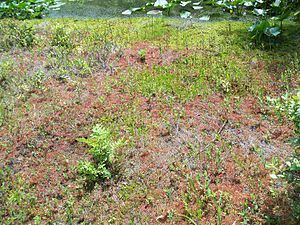Area 10 ha Nearest city Michigan City | Designated 1965 Established 1966 Management National Park Service | |
 | ||
Similar Cowles Bog, Portland Arch Nature Pr, Mount Baldy, Selmier State Forest, Hoosier Prairie State Nat | ||
Pinhook Bog is a unique bog in Indiana that has been designated a National Natural Landmark. It is part of the Indiana Dunes National Lakeshore, an area that many citizens, scientists, and politicians fought hard to preserve. Its sister bog, Volo Bog, is located nearby. The bog contains a large variety of plants, including insect eating plants, tamarack trees, stands of blueberry bushes, and floating mats of sphagnum moss. Pinhook Bog is about 580 acres (2.3 km2), a quarter of which is a floating mat of sphagnum peat moss. A "moat" separates the bog from the uplands.
Contents
Map of Pinhook Bog, Coolspring Township, IN 46350, USA
GeologyEdit
The bog is a glacial kettle. At the end of the Wisconsin Glacial epoch about 14,000 to 15,000 years ago, a large chunk of ice remained buried at this location as the ice retreated northward. When the ice melted, the clay soil sealed the basins.
The runoff from higher ground around the bog is the only water source. There is no stream or groundwater inflow or outflow. Evaporation from the open water and plants is the only loss of moisture. A bog differs from swamps, marshes, and ponds because of this limited exchange of water. The water in the bog is stagnant, acidic, and nutrient-poor.
PlantsEdit
The outstanding feature of Pinhook Bog is the tree-covered mat of sphagnum moss. Sphagnum moss is a stringy, delicate moss of a light-green color. The mat floats on top of the water and can become 3 to 6 feet (0.91 to 1.83 m) thick, yet it can have a pocket only a few inches thick in the middle. As the mat thickens, larger and larger plants take root and grow. Under the mat a peat bed develops. The acidic water slows the decay of the sphagnum moss and other plants. With time, the peat may fill the bog from the mat to the bottom. As the moisture becomes less acidic, typical land plants take root and the bog disappears.
Orchids:
Poison sumac is prevalent in the bog area, particularly around the outer edge, the ‘”moat”. It is recognized by its compound leaves of seven to thirteen leaflets. The leaflets have smooth edges and are pointed.
Tamarack or American larch is an unusual tree for northwest Indiana. It is a conifer, but not an evergreen. It drops its leaves in the winter. As fall approaches, the needles turn golden until they fall off.
Blueberry and cranberry shrubs are common along the margins. Rusty cotton grass farther down the trail flourishes.
AccessEdit
The Pinhook Bog is open for specially scheduled ranger-guided tours and for infrequent open houses. From the parking lot off Wozniak Road, a leisurely trail of about 1/2 mile leads you through the woods to the entrance to the bog, which is gated and locked during non-tour hours. Within the bog, you can walk along a plastic boardwalk which is about 1/4 mile long. You are not allowed to step on the bog as it damages the fragile ecosystem. Make sure to pay close attention to the carnivorous plants on the bog surface near the entrance - some are quite small and delicate and can be easy to miss.
For summer 2014, open houses are scheduled on Sundays from June 15 through August 17, from 12-3 pm. Tour details can be obtained at the Indiana Dunes National Lakeshore Visitor Center at (219) 926-7561. Call to confirm tour dates and times, and/or check the park newspaper, The Singing Sands.
